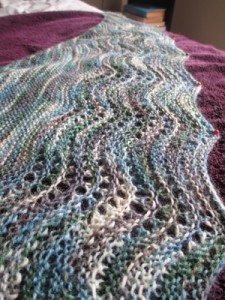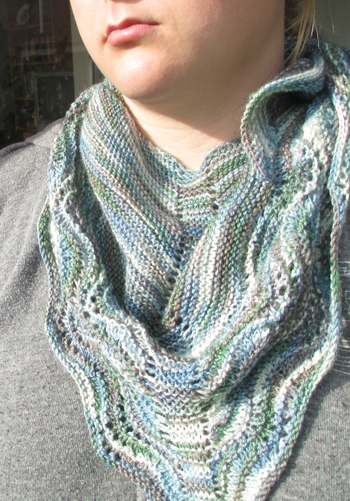
A couple weeks ago at knitting meetup (gosh, has it been that long?) Jenn chastized me for not fixing the dropped stitch in my Multnomah and blocking it, despite having cast off the sucker more than a month earlier. She urged me to “take the five minutes” and fix the stitch.
To be honest, what was stopping me was that I didn’t know how and didn’t want to screw it up. Basically it was a dropped stitch that I didn’t notice, but I must have realized a few rows later I was short one stitch, so I fudged it. I later caught the slowly unravelling rogue stitch, and popped a safety pin in it to prevent further damage.

To fix the stitch (sorry, no pictures) I ‘knit’ the fallen stitch back up as far as I could go with a crochet hook, and then anchored it in place with a tapestry needle. I admit, I winged it with the anchoring part—just sort of threaded a scrap of yarn in, did a couple loops around some nearby stitches, and then wove the ends in. You can’t tell that it’s there once I blocked it. Oddly though, the yarn broke somewhereelse while blocking it, so that I had to tie a knot unfortunately.
 Overall Multnomah [Ravelry link] is a nice (and free!) pattern, and great for such a variegated yarn like this Huckleberry Knits ‘Snowdrop’ that I bought at Apple Yarns in Bellingham, WA a couple years ago. The four-row feather and fan is simple enough to knit at meetups (although my wonky center stitches are due to long knitting absences and miscounts). I would rather fudge something than tink/rip back a more than a row.
Overall Multnomah [Ravelry link] is a nice (and free!) pattern, and great for such a variegated yarn like this Huckleberry Knits ‘Snowdrop’ that I bought at Apple Yarns in Bellingham, WA a couple years ago. The four-row feather and fan is simple enough to knit at meetups (although my wonky center stitches are due to long knitting absences and miscounts). I would rather fudge something than tink/rip back a more than a row.
Wearing Multnomah is a bit odd as a scarflette, as modelled by me in these photos. I find it has the tendency to slide low on my neck, which is probably due to the quickly increased/decreased sides. I find I need to double-knot it loosely behind my neck instead of just draping it like some of my other scarflettes.







November 6, 2012 at 1:46 pm
It looks great!